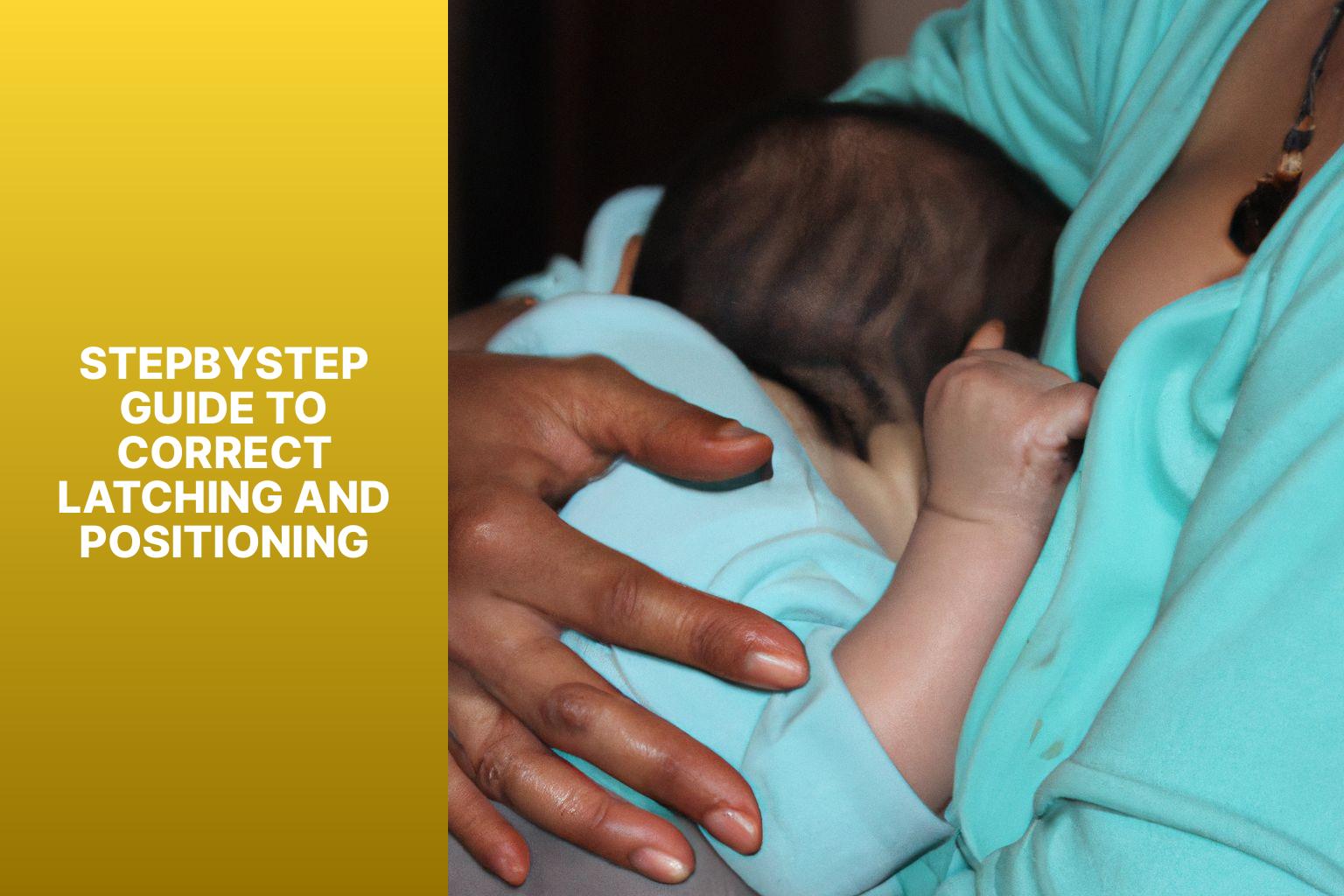Step-by-Step Guide to Correct Latching and Positioning
Breastfeeding is a beautiful and bonding experience between a mother and baby. One of the key factors that contribute to successful breastfeeding is correct latching and positioning. This step-by-step guide will help you understand the importance of correct latching and positioning and provide you with practical tips to ensure a comfortable and efficient breastfeeding journey.
Correct latching and positioning play a crucial role in ensuring effective milk transfer, preventing nipple soreness, and promoting a satisfying feeding experience for both the mother and baby. When the baby latches onto the breast correctly and is properly positioned, it allows for optimal milk flow and stimulates the milk supply. Correct latching and positioning help prevent issues such as inadequate milk transfer and breast engorgement.
Before initiating breastfeeding, it is important to prepare yourself and create a conducive environment for a successful latch.
Keep essentials like nursing pillows, burp cloths, and nipple creams within reach to ensure comfort and convenience during breastfeeding sessions.
Choose a quiet and peaceful space where you can relax and focus on your baby. Creating a calm environment helps both you and your baby to establish a deep connection and promotes better latch and positioning.
A proper latch is essential for effective breastfeeding. Follow these steps to achieve correct latching:
- Position yourself comfortably and bring the baby close to your breast, making sure their nose is aligned with your nipple.
- Hold the baby in a way that their body faces yours, with their head and neck in a straight line.
- Use your hand to form a “C” shape around the breast, gently supporting it to guide the baby to the nipple.
- Direct your nipple towards the baby’s lower lip and wait for them to open their mouth wide.
Step 5: Allow the Baby to Take the Lead
Importance of Correct Latching and Positioning
Proper latching and positioning are essential for successful breastfeeding. Here’s why correct latching and positioning are important:
- Optimal Milk Transfer: When a baby latches correctly, it ensures that they can effectively remove milk from the breast. This leads to efficient milk transfer and helps maintain a good milk supply.
- Comfort for the Mother: Correct latching and positioning reduce the likelihood of nipple pain, soreness, and damage. When the baby is positioned well, the mother can breastfeed comfortably and without discomfort.
- Effective Milk Removal: A proper latch allows the baby to create a seal around the breast, which enables them to extract milk more effectively. This helps prevent issues like poor weight gain in infants.
- Prevention of Engorgement and Mastitis: When milk is removed efficiently, it helps prevent issues like breast engorgement and mastitis. Proper latching and positioning ensure that the breasts are emptied adequately during breastfeeding.
- Promotion of Milk Supply: When a baby latches correctly and effectively removes milk, it stimulates the breasts to produce more milk. This helps establish and maintain a healthy milk supply.
- Bonding and Emotional Connection: Correct latching and positioning during breastfeeding promote a sense of closeness, bonding, and emotional connection between the mother and baby. It enhances the breastfeeding experience for both.
- Prevention of Nursing Strikes: When the baby is latched well and breastfeeding is comfortable, it reduces the likelihood of nursing strikes or refusal to breastfeed.
- Improved Digestion: Proper latching and positioning ensure that the baby can swallow milk effectively, reducing the chances of swallowing air and promoting better digestion.
- Overall Satisfaction: When breastfeeding is comfortable and effective, it contributes to the overall satisfaction and enjoyment of the breastfeeding journey for both the mother and baby.
By understanding the importance of correct latching and positioning, mothers can seek guidance and support to ensure a successful and fulfilling breastfeeding experience.
Why is Correct Latching and Positioning Important for Breastfeeding?
Why is Correct Latching and Positioning Important for Breastfeeding?
Proper latching and positioning are crucial for successful breastfeeding. When it comes to breastfeeding, correct latching ensures that the baby can effectively extract milk from the breast, while proper positioning promotes comfort and prevents nipple soreness. It plays a significant role in preventing issues such as inadequate milk transfer and breast engorgement.
To latch correctly, the baby’s mouth should cover a large part of the areola, not just the nipple. This ensures that the baby can effectively stimulate milk flow and receive a sufficient amount of milk. In addition to latching, correct positioning of the baby’s body is also important. It helps align their ear, shoulder, and hip, creating a straight and comfortable position that allows for easy swallowing and digestion.
The importance of correct latching and positioning goes beyond the initial breastfeeding experience. It helps establish a good milk supply and prevents problems such as nipple pain, which can discourage mothers from continuing breastfeeding. By ensuring proper latching and positioning, mothers can ensure that their babies receive the necessary nutrients and hydration to support their growth and development.
Understanding the significance of correct latching and positioning is essential for a successful and enjoyable breastfeeding journey for both mothers and their babies. Seeking guidance from lactation consultants or attending breastfeeding classes can provide valuable support and assistance in mastering these essential techniques.
Preparing for Correct Latching and Positioning
Get ready for successful breastfeeding by preparing for correct latching and positioning! In this section, we will dive into the essentials of ensuring a smooth breastfeeding journey. Discover the importance of gathering necessary supplies and creating a calm and cozy environment. Say goodbye to any worries and get ready to embrace the joy of nurturing your little one as we explore the key aspects of preparing for correct latching and positioning.
Gather Necessary Supplies
To properly gather the necessary supplies for correct latching and positioning during breastfeeding, follow these steps:
- Firstly, wash your hands thoroughly with soap and warm water to ensure cleanliness.
- Next, get a comfortable nursing pillow or cushion to support your baby and help maintain a good latch.
- Make sure you have a nursing bra or a comfortable top that allows easy access to your breasts.
- Keep breastfeeding pads or nipple shields handy in case of any discomfort or leakage.
- Always have a bottle of water nearby to stay hydrated during breastfeeding.
- Keep a burp cloth or towel within reach to clean up any spills or drool.
- Have a nursing cover or blanket available for privacy if desired.
- Don’t forget to keep a small pillow or cushion for your own comfort and support during breastfeeding.
Pro-tip: It’s a good idea to have a breastfeeding support book or website bookmarked for quick reference and guidance during your breastfeeding journey. Remember, every mother and baby is unique, so finding the right supplies and techniques that work for you both may take some trial and error. Stay patient and seek assistance from a lactation consultant if needed.
Find a Comfortable and Quiet Environment
When it comes to breastfeeding, it’s essential to find a comfortable and quiet environment for both the mother and the baby. Here are the steps to create the ideal environment:
- Choose a quiet location: Find a comfortable and quiet environment by locating a room or area in your home where you can have some privacy and minimize distractions. This will help you and your baby focus on the breastfeeding session.
- Get comfortable: To find a comfortable and quiet environment, find a chair or use pillows to support your back and arms. It’s crucial for you to feel relaxed and at ease during breastfeeding.
- Create a calm atmosphere: To find a comfortable and quiet environment, dim the lights or use a soft light source, such as a lamp, to create a soothing ambiance. This will help you and your baby feel more calm and relaxed.
- Eliminate distractions: To find a comfortable and quiet environment, turn off the TV, mute your phone, and minimize any background noise that could disrupt the breastfeeding session. This will help you and your baby stay focused on the task at hand.
- Adjust the temperature: To find a comfortable and quiet environment, ensure that the room is at a comfortable temperature for both you and your baby. Being too hot or too cold can make breastfeeding uncomfortable.
By following these steps, you can find a comfortable and quiet environment that promotes a successful breastfeeding experience for both you and your baby.
Step-by-Step Guide to Correct Latching
Discover the art of correct latching, a crucial skill for successful breastfeeding. In this step-by-step guide, we’ll delve into the essential techniques to ensure a proper latch. From establishing a proper hierarchy to positioning the baby and supporting the breast, we’ll cover it all. Learn how to aim for the baby’s mouth and allow them to take the lead in this seamless process. Mastering correct latching is the key to a comfortable and fulfilling breastfeeding experience.
Step 1: Ensure a Proper Hierarchy
To ensure a proper hierarchy in latching and positioning during breastfeeding, follow these steps:
- Step 1: Start by sitting or reclining in a comfortable position.
- Support your back with pillows if needed to maintain a good posture.
- Place a nursing pillow or rolled-up blanket on your lap to elevate your baby.
- Make sure your baby’s body is aligned and facing towards you.
- Ensure that the baby’s head is in line with their body and not tilted or turned to one side.
- Bring your baby close to your breast, aiming their nose towards your nipple.
- Support your breast with your hand in a C-shaped hold, with your thumb on top and fingers below.
- Wait for your baby’s mouth to open wide with their tongue down before bringing them to latch.
- Bring your baby’s lower lip and chin onto your breast first, followed by the upper lip.
- Make sure your baby’s mouth covers a large portion of your areola, not just the nipple.
By ensuring a proper hierarchy in latching, you can help your baby latch correctly, which is essential for successful breastfeeding.
Step 2: Position the Baby
- Step 2: Position the Baby
- Hold the baby in a comfortable and supported position, with their head facing your breast.
- Bring the baby close to your breast, ensuring their nose is in line with your nipple.
- Support the baby’s neck and shoulders with your hand, using the “C” hold technique.
- With your nipple pointing towards the baby’s upper lip, gently tickle their lower lip to encourage them to open their mouth.
- When the baby’s mouth is wide open, lead with your nipple and aim it towards the roof of their mouth.
To ensure a correct latch during breastfeeding, it is important to position the baby properly. Follow these steps:
By positioning the baby correctly, you allow them to have a deep latch and maximize milk transfer. It also helps prevent nipple soreness and promotes effective feeding.
Step 3: Support the Breast
The step-by-step guide to supporting the breast during breastfeeding is as follows:
- Ensure a comfortable seating position.
- Place a pillow or breastfeeding support pillow on your lap or at your side for added comfort and support.
- Step 3: Support the Breast – Use your hand or fingers to shape your breast, forming a “C” or “U” shape around the areola (the dark area surrounding the nipple).
- Keep your fingers away from the areola and nipple to avoid interfering with your baby’s latch.
- Use your hand to support the weight of your breast, holding it in a stable position.
- Raise your breast slightly towards your baby’s mouth to make it easier for them to latch on.
- Avoid applying too much pressure or pulling on your breast, as this can cause discomfort and affect the latch.
- Be mindful of any signs of discomfort or pain while supporting your breast and adjust your hand positioning if necessary.
- Continue to support your breast throughout the feeding session to ensure a comfortable and secure latch for your baby.
- Remove your hand once your baby is latched on properly, allowing them to nurse freely.
Supporting the breast during breastfeeding is crucial as it helps your baby effectively latch on and ensures a comfortable and efficient feeding experience for both you and your baby.
Step 4: Aim for the Baby’s Mouth
- Position yourself comfortably, with your back supported and your feet flat on the ground.
- Gently cradle your baby’s head with one hand, supporting the neck and shoulders.
- Use your other hand to support your breast, forming a “C” shape around the areola.
- Bring your baby’s mouth towards your breast, aiming for the center of the areola.
- Wait for your baby to open their mouth wide, with their tongue down and lower lip rolled out.
- Quickly bring your baby onto the breast, ensuring that their mouth covers a large part of the areola.
- Make sure their chin is touching the breast, and their nose is slightly away to allow for breathing.
- Ensure a good latch by checking for proper alignment between the baby’s mouth, nipple, and areola.
- Once latched, you should feel a pulling and sucking sensation, but it should not be painful.
Pro-tip: If you’re having trouble aiming for the baby’s mouth, try holding your breast with both hands to ensure a stable and secure grip. This can help you guide your baby’s mouth to the correct position more easily.
Step 5: Allow the Baby to Take the Lead
Step 5: Allow the Baby to Take the Lead
- Ensure that you and your baby are in a comfortable and relaxed position.
- Hold your breast with your hand in a C-shape, supporting it from underneath.
- With your nipple aligned with your baby’s nose, gently touch their upper lip with it.
- Wait for your baby to open their mouth wide, showing their tongue and the inner part of their mouth.
- Once their mouth is wide open, bring your baby closer to your breast, aiming their lower lip to latch onto the areola.
- Let your baby take the lead by allowing them to take as much breast tissue as they can into their mouth.
- Ensure that their lips are flanged outward, covering a wide area of the areola.
- Observe for signs of effective latch such as rhythmic sucking and swallowing.
Remember, each baby is unique, and it may take a few attempts to find the perfect latch. Be patient and allow your baby to guide the process. Seek assistance from a lactation consultant if you continue to experience difficulties.
Step-by-Step Guide to Correct Positioning
Find your perfect position and ensure an optimal latch for both you and your baby. In this step-by-step guide to correct positioning, we’ll walk you through each crucial stage of achieving proper alignment. Step 1 involves finding a comfortable position for yourself, while Step 2 focuses on positioning your baby’s body. Next, in Step 3, we’ll guide you on aligning your baby’s ear, shoulder, and hip. And finally, Step 4 will help you check for comfort and accessibility. Get ready for a seamless and rewarding breastfeeding experience.
Step 1: Find a Comfortable Position for Yourself
- Step 1: Find a Comfortable Position for Yourself. When it comes to breastfeeding, finding a comfortable position for yourself is crucial. Follow these steps to ensure a comfortable and relaxed breastfeeding experience:
- Find a quiet and peaceful environment where you can sit or lie down comfortably.
- Position yourself with proper back support, either using pillows or a nursing chair.
- Choose a position that works best for you, such as the cradle hold, football hold, or side-lying position.
- Ensure your feet are well-supported and your arms are relaxed.
- Align your body and baby’s body in a way that promotes a comfortable latch and allows easy access to the breast.
Finding a comfortable position for yourself not only enhances your breastfeeding experience but also helps prevent back and neck pain. Remember, every nursing mother is unique, so it’s essential to experiment with different positions until you find the one that works best for you and your baby.
Step 2: Position the Baby’s Body
- Ensure that you are in a comfortable position before positioning the baby’s body.
- Step 2: Position the Baby’s Body
- Hold the baby in a way that their head is aligned with their body, making sure their neck is supported.
- Keep the baby’s body close to yours, with their chest and tummy facing you.
- Make sure the baby’s body is straight and not slouched or twisted.
- Position the baby’s legs in a relaxed and comfortable position, allowing them to naturally bend at the knees.
- Support the baby’s back and shoulders with one hand while holding their bottom securely with the other.
- Take note of any discomfort or tension in your body and adjust the baby’s position accordingly.
- Ensure that the baby’s mouth is in line with your nipple for a proper latch.
- Allow the baby’s arms to freely move while breastfeeding.
To achieve a comfortable and effective breastfeeding experience, it is important to position the baby’s body correctly. Ensuring that both you and the baby are comfortable during breastfeeding will promote a better latch and milk transfer. Remember to adjust the baby’s position as needed for optimal comfort and accessibility.
Step 3: Align the Baby’s Ear, Shoulder, and Hip
- Step 3: Align the Baby’s Ear, Shoulder, and Hip
- Step 3.1: Gently cradle the baby’s head with one hand, supporting the neck and allowing the baby’s ear to be in line with their shoulder.
- Step 3.2: Position the baby’s body so that their shoulder and hip are in alignment, creating a straight line.
- Step 3.3: This alignment helps the baby create a proper latch by allowing them to open their mouth wide and create a good seal around the breast.
- Step 3.4: Avoid any twisting or turning of the baby’s body as it can lead to discomfort and difficulty during breastfeeding.
Once you have positioned the baby, it is important to ensure that the baby’s ear, shoulder, and hip are in alignment to promote a comfortable and effective latch.
Focusing on aligning the baby’s ear, shoulder, and hip during breastfeeding can contribute to a better latch and more comfortable feeding experience for both the baby and the mother.
Step 4: Check for Comfort and Accessibility
Step 4: Check for Comfort and Accessibility
- Ensure that you are in a comfortable position before latching your baby. Sit in a chair with good back support or use pillows to prop yourself up.
- Check that your baby’s body is aligned with their head and body facing towards you. Use your hand to support their neck and head if needed.
- Make sure that the baby’s ear, shoulder, and hip are in a straight line. This helps to ensure proper alignment for a good latch.
- Check for comfort and accessibility of the breast. The baby’s nose should be close to the breast without being blocked, allowing them to breathe comfortably.
- Ensure that the baby’s mouth is wide open with their lips flanged outward, covering a large portion of the areola. This allows for a deeper latch and better milk transfer.
Pro-tip: Experiment with different breastfeeding positions, such as the football hold or cross-cradle hold, to find what is most comfortable and accessible for you and your baby. Remember, it may take some time and practice to find the position that works best for both of you.
Common Challenges and Solutions
Struggling with latching and positioning while breastfeeding? Don’t worry, we’ve got your back! In this section, we’ll explore common challenges that many new moms face and provide practical solutions to overcome them. From dealing with sore nipples to ensuring adequate milk transfer and tackling breast engorgement, we’ll dive into each sub-section to equip you with the know-how and tips to make your breastfeeding journey smoother. No need to fret, we’re here to help you navigate through these hurdles with confidence!
Sore Nipples
Dealing with sore nipples is a common challenge that many breastfeeding mothers may encounter during their journey. However, there are effective ways to alleviate this discomfort and continue breastfeeding successfully.
- One important solution is to ensure a proper latch. It is crucial that your baby’s mouth covers a large portion of the areola, rather than just the nipple. This will help prevent soreness.
- Checking and adjusting your positioning is also key. Incorrect positioning can lead to nipple pain. Ensure that your baby’s body is aligned, with their ear, shoulder, and hip forming a straight line.
- If you are facing persistent soreness, do not hesitate to seek assistance from a lactation consultant. They can provide you with valuable guidance and support, helping you address any latch or positioning issues you may have.
- Furthermore, using nipple creams or ointments can be beneficial. Applying products like lanolin or other soothing creams can help moisturize and alleviate the discomfort in your sore nipples.
- Preventing breast engorgement is also crucial. Engorgement can make latching more difficult and contribute to nipple pain. Breastfeed your baby frequently and utilize warm compresses or gentle massage techniques to relieve the engorgement.
Here’s a pro-tip: You can take care of your nipples by wearing nursing pads that are gentle on the skin and avoid any excessive friction or rubbing. By prioritizing your comfort and seeking the necessary support, you can overcome sore nipples and establish a successful and fulfilling breastfeeding journey.
Inadequate Milk Transfer
Inadequate milk transfer during breastfeeding can be a common challenge for some mothers and babies. It occurs when the baby is not able to effectively remove milk from the breast, leading to insufficient milk supply or slow weight gain in the baby.
To address inadequate milk transfer, there are several steps you can take:
1. Ensure proper latching and positioning: A correct latch is crucial for effective milk transfer. Make sure the baby’s mouth covers a large portion of the areola, with the nipple reaching the baby’s soft palate. This helps the baby create a good seal and effectively extract milk.
2. Seek assistance from a lactation consultant: If you are experiencing inadequate milk transfer, consulting a lactation consultant can provide valuable guidance and support. They can assess the latch and provide techniques to improve milk transfer.
3. Increase breastfeeding frequency: Offering the breast more frequently can help stimulate milk production and ensure the baby gets enough milk. Aim for at least 8-12 feedings in a 24-hour period, including nighttime feedings.
4. Empty the breast fully: Encouraging the baby to nurse fully on one breast before switching sides can help ensure the breast is emptied thoroughly, promoting increased milk supply.
5. Consider breast compressions: Using breast compressions during feeding can help to further stimulate milk flow and encourage the baby to actively take in more milk.
It’s important to remember that inadequate milk transfer can have various causes, including latch issues, tongue ties, or low milk supply. Seeking professional support and maintaining open communication with healthcare providers can help address and overcome this challenge.
Breast Engorgement
- Breast engorgement, which occurs when the breasts become overfilled with milk, can cause them to feel full, tight, and painful.
- This condition can occur in the early days after giving birth, when milk production is still establishing, or it may occur later due to a sudden increase in milk supply.
- Engorgement can make it challenging for the baby to latch onto the breast properly, thus leading to breastfeeding difficulties.
- To relieve breast engorgement, it is important to regularly empty the breasts. This can be achieved through on-demand breastfeeding or pumping if necessary.
- Using warm compresses or taking showers can also aid in improving milk flow and reducing discomfort.
- Avoiding tight-fitting bras or clothing that can restrict milk flow and worsen engorgement is crucial.
- If engorgement persists or becomes severe, seeking support from a lactation consultant or healthcare provider is advisable.
- Breast engorgement can be prevented by frequent breastfeeding, ensuring proper latch and positioning, and gradually implementing any necessary changes to breastfeeding routines.
- Maintaining a well-hydrated state and following a balanced diet are also important for supporting milk production and overall breast health.
Troubleshooting Latching and Positioning Issues
If you are experiencing latching and positioning issues while breastfeeding, follow these steps to troubleshoot the problem:
- Check Baby’s Position: Ensure that your baby is properly positioned for breastfeeding. The baby’s body should be facing you, with their nose in line with your nipple.
- Support Your Breast: Use your hand or a breastfeeding pillow to support your breast. This helps your baby have better access to the nipple and areola.
- Align Baby’s Mouth: Make sure your baby’s mouth is wide open before latching. Gently tickle their lower lip with your nipple to encourage them to open wide.
- Bring Baby to Breast: Bring your baby to your breast, aiming their lower lip to touch the lower part of your areola. This helps ensure a deep latch.
- Check Latch: Assess the latch by observing your baby’s mouth. A proper latch involves the baby’s lips flanged out, covering a large portion of the areola.
- Break Suction: If the latch is shallow or painful, insert your clean finger into the corner of your baby’s mouth to break the suction and try latching again.
- Relax: Find a comfortable and relaxed position for breastfeeding. Stress and tension can affect both your milk flow and your baby’s ability to latch properly.
- Seek Support: If you continue to experience latching and positioning difficulties, consult a lactation consultant or a healthcare professional who can provide personalized guidance and assistance.
- Persistent Pain: If you are experiencing persistent pain during breastfeeding, consult with a healthcare professional to rule out any underlying issues, such as thrush or tongue tie.
- Practice and Patience: Remember that latching and positioning can take time and practice for both you and your baby. Be patient, and don’t hesitate to seek help when needed.
By troubleshooting latching and positioning issues and seeking appropriate support, you can improve your breastfeeding experience and ensure your baby is getting the nourishment they need.
Tips for Successful Latching and Positioning
Follow these tips to ensure successful latching and positioning while breastfeeding:
- Find a Comfortable Position: Sit in a comfortable chair or use pillows to support your back and arms. Choose a position that allows you to relax and maintain good posture.
- Bring Baby to Breast: Bring your baby close to your breast, aligning their nose with your nipple. Their mouth should be wide open, and their chin should touch your breast first.
- Support Baby’s Neck and Shoulders: Use your hand to support the back of your baby’s neck and shoulders, ensuring their head is in a neutral position.
- Wait for a Wide Mouth: Wait for your baby to open their mouth wide before bringing them onto your breast. This will help ensure a deep latch.
- Aim for a Deep Latch: Bring your baby’s lower lip and chin to your breast first, aiming for a wide latch. Their lips should be flanged outward, covering a significant portion of the areola.
- Listen for Swallowing: Once your baby is latched correctly, you should hear a rhythmic pattern of swallowing. This indicates that they are efficiently feeding.
- Check for Comfort: Breastfeeding should not be painful. If you experience pain, unlatch your baby by inserting your clean finger into the corner of their mouth and try latching again.
- Switch Nursing Positions: Experiment with different breastfeeding positions to find what works best for you and your baby. Some common positions include cradle hold, football hold, and side-lying position.
- Take Breaks if Needed: If you or your baby become tired or frustrated during breastfeeding, it’s okay to take short breaks. Gently remove your baby’s latch and offer comfort before resuming.
- Seek Support: If you continue to experience difficulties with latching or positioning, seek assistance from a lactation consultant or a healthcare professional. They can provide personalized guidance and support.
With practice and patience, you and your baby can establish a comfortable and successful breastfeeding routine through proper latching and positioning.
Frequently Asked Questions
What is the learning curve for achieving a proper latch during breastfeeding?
The learning curve for achieving a proper latch during breastfeeding can vary for each mother and baby. It may take time and trial and error to find the right latch position that works best for both of you. It is important to be patient and persistent in trying different techniques.
How can I ensure a proper latch during breastfeeding?
To ensure a proper latch during breastfeeding, start by holding your breast and shaping it to resemble your baby’s mouth. Bring your baby to the breast, stroking their cheek to trigger the rooting reflex and tickling their lips with the nipple until their mouth opens wide. Quickly bring them to the breast, making sure they take in both the nipple and areola. A proper latch is indicated by the baby’s chin and nose touching the breast, and their lips flanged out.
What should I do if I experience a painful latch during breastfeeding?
If you experience a painful latch during breastfeeding, it is likely that your baby is not latched on properly. In this case, it is important to unlatch and reposition your baby. Adjusting the positioning, ensuring a wide open mouth, and bringing the baby closer to the breast can help improve the latch and reduce nipple pain.
How can I deal with clicking noises while breastfeeding?
Clicking noises while breastfeeding may indicate that your baby is not latched on properly. It is important to unlatch and reposition your baby to achieve a better latch. Remember to make sure that the baby’s chin and nose are touching the breast, and their lips are flanged out. Practice patience and keep trying different techniques until you find a comfortable and effective latch.
What are some common breastfeeding holds that can help with latching?
There are several breastfeeding holds that can help with latching. Some common positions include the crossover, cradle hold, football hold, laid-back, and side lying positions. Experiment with different holds to find what works best for you and your baby’s latch.
When should I seek help from a breastfeeding specialist or family physician?
If you are experiencing persistent difficulties with latching and breastfeeding, it may be beneficial to seek help from a breastfeeding specialist or your family physician. They can provide expert advice, support, and additional techniques to address any latch issues you may be facing. Remember, seeking timely help is important for a successful breastfeeding journey.










